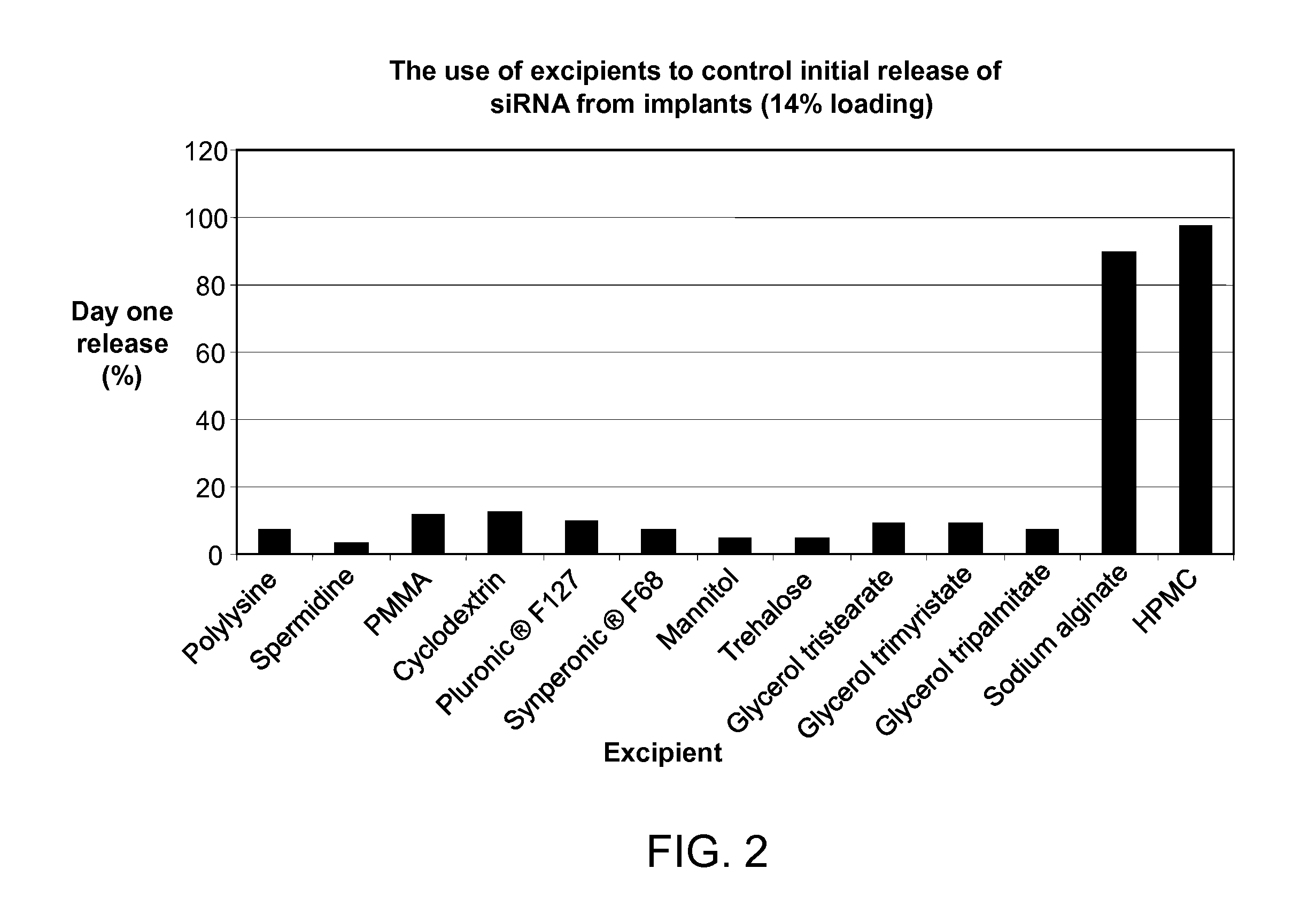METHOD OF CONTROLLING INITIAL DRUG RELEASE OF siRNA FROM SUSTAINED-RELEASE IMPLANTS
a technology of sustained-release implants and sirna, which is applied in the field of ocular implants, can solve the problems of high initial rate of release, difficult to form positive and highly water soluble sirnas into sustained-release, and difficult to control the transfection of exogenous sirna
- Summary
- Abstract
- Description
- Claims
- Application Information
AI Technical Summary
Benefits of technology
Problems solved by technology
Method used
Image
Examples
example 1
[0086]Measuring the initial burst release of siRNA from an implant
[0087]The initial burst release of siRNA from a biodegradable implant was assayed in vitro as follows: siRNA implants were prepared and then placed in phosphate buffered saline (PBS), 0.01 M, pH 7.4 (release medium) at 37° C. in a shaking water bath. At the desired time (e.g., 24 hrs after placement in the release medium), the implant-containing PBS solution was sampled. The amount of siRNA in a sample was quantified by reverse phase HPLC.
[0088]To study the effect of siRNA load on the initial burst release of siRNA from an implant, we prepared implants containing increasing amounts of an siRNA (siRNA 027) in a PLGA polymer, (i.e., the Boehringer Ingelheim Resomer RG752S). As shown in FIG. 1, increasing the load of siRNA from 1% to 10% (w / w) in the implant increased the initial burst release of siRNA on day one from about 5% to about 40%.
example 2
[0089]Controlling the initial burst release of siRNA from an implant
[0090]The initial burst release of siRNA from implants can be retarded by the selective use of certain pharmaceutical excipients. To explore the effect of various excipients on the initial burst release of siRNA from an implant, a series of implants with different excipients were prepared and then evaluated as described in Example 1. Each implant contained 5% (w / w) excipient, 14% (w / w) siRNA-027, and 81% (w / w) PLGA polymer RG752S. The excipients tested are set forth in FIG. 2. As shown in FIG. 2, the inclusion of certain excipients in a biodegradable polymeric matrix (such as one comprising PLGA) significantly reduces the initial burst release of siRNA from the implant, as compared to implants without excipient. As compared to an implant having no excipient and consisting essentially of siRNA and a biodegradable polymer, as shown in FIG. 1, the inclusion of excipient (shown in FIG. 2) reduced the initial day one rel...
PUM
| Property | Measurement | Unit |
|---|---|---|
| time | aaaaa | aaaaa |
| size | aaaaa | aaaaa |
| size | aaaaa | aaaaa |
Abstract
Description
Claims
Application Information
 Login to View More
Login to View More - R&D
- Intellectual Property
- Life Sciences
- Materials
- Tech Scout
- Unparalleled Data Quality
- Higher Quality Content
- 60% Fewer Hallucinations
Browse by: Latest US Patents, China's latest patents, Technical Efficacy Thesaurus, Application Domain, Technology Topic, Popular Technical Reports.
© 2025 PatSnap. All rights reserved.Legal|Privacy policy|Modern Slavery Act Transparency Statement|Sitemap|About US| Contact US: help@patsnap.com


